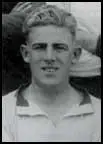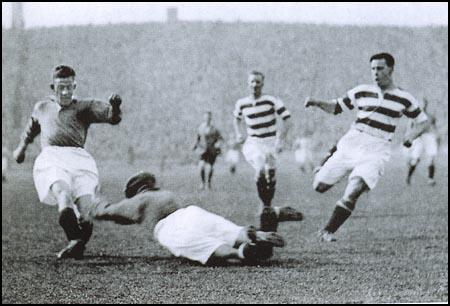Sam English

Samuel English was born in Coleraine, County Londonderry, in July, 1910. In 1924 his family moved to Dalmuir in Scotland, and for a time he worked at the John Brown & Company Shipyard.
English, a goalscoring centre-forward, played football for Yoker Athletic before signing as a professional for Glasgow Rangers in July, 1931.
On 5th September, 1931, Celtic played Rangers in front of an 80,000 crowd at Ibrox Stadium in Glasgow. Early in the second half Sam English raced through the Celtic defence and looked certain to score, when John Thomson dived at his feet. Thomson's head collided with English's knee and he was taken unconscious from the field. According to The Scotsman, Thomson "was seen to rise on the stretcher and look towards the goal and the spot where the accident happened". Thomson was taken to the Victoria Infirmary but he had fractured his skull and he died at 9.25 that evening.

The official enquiry later found that the collision was an accident, and cleared English of any blame. However, he was always jeered by Scottish crowds during future games. This did not stop English from having a great first season, scoring a record 53 goals (44 in the league). He also won a Scottish Cup medal in 1932 when when Rangers beat Kilmarnock 3-0.
The following season English helped Rangers win the First Division of the Scottish League. That year he won two international caps for Northern Ireland.
In August 1933 Liverpool paid £8,000 for English. He had a good start scoring 13 goals in his first 16 games in the First Division of the Football League. He ended the season with 21 goals. The 1934-35 season was more of a struggle and in July 1935 he was sold to Queen of the South for £1,700. This move was not a success and in July 1936 he was given a free transfer to Hartlepool United.
English retired from football in May 1938. He told a friend that since the accident that killed John Thomson he had "seven years of joyless sport". He worked as a coach for Duntocher Hibernians and Yoker Athletic before finding employment in a shipyard.
Sam English was forced to retire early when he developed motor neurone disease. He died in the Vale of Leven Hospital, in West Dunbartonshire in April 1967.
Primary Sources
(1) Nick Hazlewood, In the Way! Goalkeepers: A Breed Apart? (1996)
More than 80,000 were at Ibrox to witness an event that has remained imprinted on the Scottish football psyche ever since. With the second half barely five minutes old, Rangers striker Sam English broke free and lined up to shoot from near the penalty spot. He seemed certain to score, when Thomson launched one of his do-or-die head-first saves at the attacker's feet. It was Thomson's trademark save - in February 1930 against Airdrie he'd been injured doing exactly the same thing, fracturing his jaw and injuring his ribs. This time there was an even more sickening crunch, Thomson's head colliding with English's knee at the moment of greatest impact. It was no longer a do-or-die moment, it was a do-and-die. The ball ran out of play, English fell to the ground and rose limping, Thomson lay unconscious, blood seeping into the pitch.
The dazed English was the first to realise the seriousness of the blow and hobbled over to the unmoving keeper, waving urgently for assistance. Celtic fans were cheering the missed goal, Rangers fans were taunting the injured keeper, but the gravity of the situation was soon upon them. Rangers' captain Davie Meiklejohn raised his arms to implore the home fans to be silent. A hush descended over the ground. In the stands Margaret Finlay, Thomson's fiancee, broke down as she saw him borne from the ground, head wrapped in bandages, body limp...
What followed was an outpouring of public grief that, it is said, briefly united communities across the sectarian divide. In Bridgeton, Glasgow, traffic was brought to a halt by thousands of pedestrians walking past a floral tribute to Thomson, placed in a shop window by the local Rangers supporters club. And at Glasgow's Trinity Congregational Church there were unruly scenes when thousands struggled to get into Thomson's memorial service. Women screamed with alarm at the crush and only swift action by police cleared a passageway and stemmed the rush. Celtic right-half Peter Wilson, who was due to read a lesson, failed to gain entrance and found himself stranded outside the church for the ceremony.
Tens of thousands went to Queen Street station to see the coffin off on its train journey home to Fife. Many thousands more made the same journey: by train, by car and by foot. Unemployed workers walked the 55 miles, spending the night on the Craigs, a group of hills behind Auchterderran. In Fife, local pits closed down for the day and it seemed as if the whole of Scotland had swelled the small streets of Cardenden. Thomson's coffin, topped by one of his international caps and a wreath in the design of an empty goal, was carried by six Celtic players the mile from his home to Bowhill cemetery, where he was laid to rest in the sad and quiet graveyard populated by the victims of many, many mining disasters.
